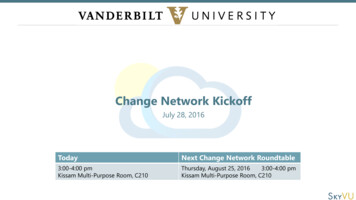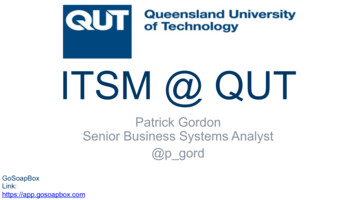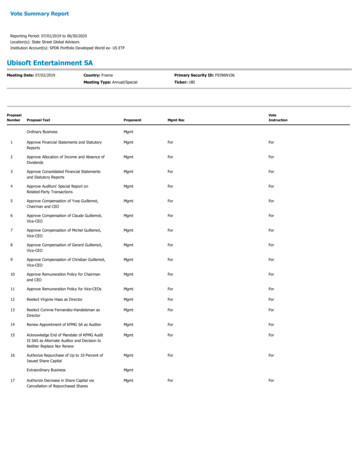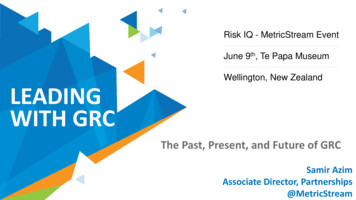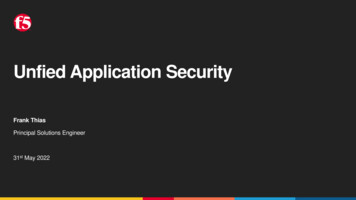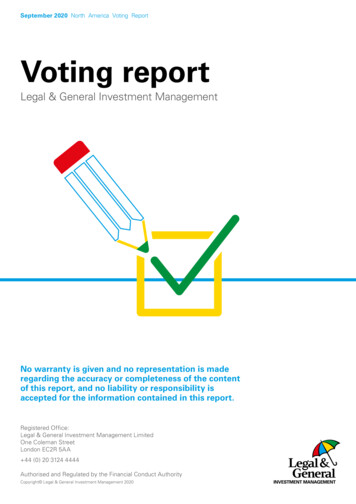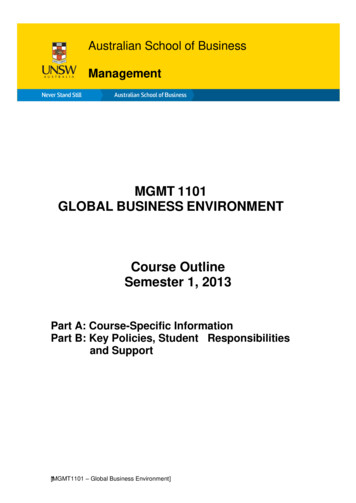
Transcription
Australian School of BusinessManagementMGMT 1101GLOBAL BUSINESS ENVIRONMENTCourse OutlineSemester 1, 2013Part A: Course-Specific InformationPart B: Key Policies, Student Responsibilitiesand Support[MGMT1101 – Global Business Environment]1
Table of ContentsPART A: COURSE-SPECIFIC INFORMATION11STAFF CONTACT DETAILS12COURSE DETAILS12.12.22.32.42.5Teaching Times and LocationsUnits of CreditSummary of CourseCourse Aims and Relationship to Other CoursesStudent Learning Outcomes122233LEARNING AND TEACHING ACTIVITIES43.1 Approach to Learning and Teaching in the Course3.2 Learning Activities and Teaching Strategies4545ASSESSMENT4.1 Formal Requirements4.2 Assessment Details4.3 Late Submission5585COURSE RESOURCES86COURSE EVALUATION AND DEVELOPMENT87COURSE SCHEDULE9PART B: KEY POLICIES, STUDENT RESPONSIBILITIES AND SUPPORT151PROGRAM LEARNING GOALS AND OUTCOMES152ACADEMIC HONESTY AND PLAGIARISM163STUDENT RESPONSIBILITIES AND CONDUCT163.13.23.33.43.5WorkloadAttendanceGeneral Conduct and BehaviourOccupational Health and SafetyKeeping Informed17171717174SPECIAL CONSIDERATION AND SUPPLEMENTARY EXAMINATIONS185STUDENT RESOURCES AND SUPPORT19[MGMT1101 – Global Business Environment]2
PART A: COURSE-SPECIFIC INFORMATION1 STAFF CONTACT DETAILSNameDr Hokyu HwangLecturer-in-Charge & TutorDr Steven LuiLecturer & TutorMr. Yulius SantosoTutorMr. Ilro LeeTutorMs. Karyn WangTutorContact DetailsManagement, ASBRoom546C, ASB buildinghokyu.hwang@unsw.edu.auManagement, ASBRoom , ASB BuildingEmail:Management, ASB5th floor, ASB Buildingy.santoso@unsw.edu.auManagement, ASB5th floor, ASB Buildingilro.lee@student.unsw.edu.auManagement, ASB5th floor, ASB BuildingConsultation HoursTBATBATBATBATBAPlease note that the Course Coordinator, Dr Hokyu Hwang will only respond to e-mailsrelating to matters or problems specific to an individual student. If you have a moregeneral query that is likely to be shared by other students, please post it to the FAQsection on the Course website. All students are to keep abreast of all postings on theAnnouncements and FAQ sections on the Course Website.2 COURSE DETAILS2.1Teaching Times and LocationsStudents must attend a 90-minute lecture and a 90-minute tutorial each week. Bothweekly lectures and tutorials will commence in Week 1. Students must ensure theyenrol themselves into a tutorial. The time and venue of tutorials may be subject tochange depending on the number of students enrolled. Students must attend thetutorial and lecture for which they are enrolled.Lectures:Tutorial:5321 ATUE 16-17:305322 BTHU 14-15:305339 H09A THU 9-10:305340 H10A THU 10:30-125333 T09B TUE9-10:305332 T10A TUE 10-12:305334 T10B TUE 13-14:305335 T13A TUE 13-14:30[MGMT1101 – Global Business Environment]CLB 8ChemScM17Australian School Business 215 (K-E12-215)Dr. Hokyu HwangAustralian School Business 215 (K-E12-215)Dr. Hokyu HwangQuad G027Dr. Steven LuiAustralian School Business 207 (K-E12-207)Ms. Karyn WangQuad G027Mr. Ilro LeeAustralian School Business 207 (K-E12-207)Ms. Karyn Wang1
5337 T13B TUE 13-14:305336 T14A TUE 14:30-165338 T14B TUE 14:30-165325 W10B WED 10:30-125326 W13A WED 13-14:305329 W14A WED 14:30-162.2Quad G046Mr. Ilro LeeAustralian School Business 215 (K-E12-215)Ms. Karyn WangQuad G046Mr. Ilro LeeAustralian School Business 207 (K-E12-207)Mr. Yulius SantosoAustralian School Business 107 (K-E12-107)Mr. Yulius SantosoAustralian School Business 207 (K-E12-207)Mr. Yulius SantosoUnits of CreditThe course is worth 6 units of credit.2.3Summary of CourseThe Course focuses on key global business environmental factors and issues thataffect firms with international operations. The main topics covered are: thedevelopment of firms with international operations, including multinational enterprises(MNEs); national differences in the economic, political, social and legal environments(including a particular focus on doing business in developing and transitionaleconomies); cultural differences and their effects on international business; theoperation of foreign exchange markets; international trade policy and the World TradeOrganisation (WTO); regional economic integration; and the impact of technology.2.4Course Aims and Relationship to Other CoursesThis Course is designed to be an introduction to international business. It is the firstcompulsory Course in the International Business major. International Business can betaken as a single major or co-major in the Bachelor of Commerce and a co-major in theBachelor of Economics. It is also offered to students majoring in International Businessas part of a Bachelor of Arts/Bachelor of Social Science.The aim of this course is to help students develop the ability to evaluate the impact ofkey business environmental factors on multinational firms and how these firms shouldrespond to them. Students majoring in International Business will go on to takeMGMT2101 (International Business and Multinational Operations) and STRT3101(International Business Strategy) in their second and third year of study.More specifically, the aims of this Course are: To introduce students to the nature of international business and theinternationalised firm; To analyse trends and changes in the current global business environment anddebate the impact of globalisation; To show how international business is affected by the many different types ofenvironments (i.e. economic, political, social, cultural, financial, technological) inwhich it operates;[MGMT1101 – Global Business Environment]2
To discuss the relevance of international institutions, governments and nongovernmental organisations to international business; and To analyse multinational firms‟ responses to threats and opportunities in the globalbusiness environment.2.5Student Learning OutcomesThe Course Learning Outcomes are what you should be able to DO by the end of thiscourse if you participate fully in learning activities and successfully complete theassessment items.The Learning Outcomes in this course also help you to achieve some of the overallProgram Learning Goals and Outcomes for all undergraduate students in the ASB.Program Learning Goals are what we want you to BE or HAVE by the time yousuccessfully complete your degree (e.g. „be an effective team player‟). Youdemonstrate this by achieving specific Program Learning Outcomes - what you areable to DO by the end of your degree (e.g. „participate collaboratively and responsiblyin teams‟).ASB Undergraduate Program Learning Goals and Outcomes1. Knowledge: Our graduates will have in-depth disciplinary knowledge applicable in local andglobal contexts.You should be able to select and apply disciplinary knowledge to business situations in a local and globalenvironment.2. Critical thinking and problem solving: Our graduates will be critical thinkers and effectiveproblem solvers.You should be able to identify and research issues in business situations, analyse the issues, and proposeappropriate and well-justified solutions.3. Communication: Our graduates will be effective professional communicators.You should be able to:a. Prepare written documents that are clear and concise, using appropriate style and presentationfor the intended audience, purpose and context, andb. Prepare and deliver oral presentations that are clear, focused, well-structured, and delivered in aprofessional manner.4. Teamwork: Our graduates will be effective team participants.You should be able to participate collaboratively and responsibly in teams, and reflect on your ownteamwork, and on the team‟s processes and ability to achieve outcomes.5. Ethical, social and environmental responsibility: Our graduates will have a sound awareness ofthe ethical, social, cultural and environmental implications of business practice.You should be able to:a. Identify and assess ethical, environmental and/or sustainability considerations in businessdecision-making and practice, andb. Identify social and cultural implications of business situations.For more information on the Undergraduate Program Learning Goals and Outcomes,see Part B of the course outline.[MGMT1101 – Global Business Environment]3
The following table shows how your Course Learning Outcomes relate to the overallProgram Learning Goals and Outcomes, and indicates where these are assessed (theymay also be practised in tutorials and other activities):Program LearningGoals and OutcomesThis course helps you toachieve the followinglearning goals for allASB undergraduatestudents:1KnowledgeCourse Learning OutcomesOn successful completion of the course,you should be able to:Course AssessmentItemThis learning outcomewill be assessed in thefollowing items:explain concepts and theories concerningthe global business environment;apply concepts about the global businessenvironment to actual businesssituations;analyse business cases in the area ofinternational business;research and write on contemporaryinternational business topics; andbuild up a good foundation for furtherstudy of international business. Tutorial questionsMemosGroup presentationExam2Critical thinkingand problemsolvingUse the concepts and models ofinternational business to interpret andanalyse real problems in global businessenvironment. Tutorial questionsMemosGroup presentationExam3aWrittencommunicationConstruct written work which is logicallyand professionally presented. Memos3bOralcommunication Group presentationand discussionfacilitation4TeamworkCommunicate ideas in a succinct andclear manner and facilitate discussion oncontemporary issues in internationalbusiness.Work collaboratively to complete tasks. ilitySocial andculturalawarenessIdentify and assess environmental andsustainability in international business. Group presentationand discussionfacilitationExamMemosIdentify and assess socio-culturalenvironments and their influences ininternational business. ExamMemos5b.3 LEARNING AND TEACHING ACTIVITIES3.1Approach to Learning and Teaching in the CourseThis course has been designed to provide a supportive context for independentlearning. As well as guiding students through the different topics of the course,teaching staff aim to assist students to „learn how to learn‟ in a university environment.The structure of the course enables students to apply the international business[MGMT1101 – Global Business Environment]4
theories and concepts they learn in lectures and the textbook to actual problems andreal-life business situations.3.2Learning Activities and Teaching StrategiesLectures do not simply reiterate material covered in the text but aim to extend it, andprovide a more detailed and sophisticated analysis of both theoretical concepts andapplied materials. In order to make the most out of lectures, the reading of textbookchapters should be completed prior to the lecture.4 ASSESSMENT4.1Formal RequirementsIn order to pass this Course, students musta) Attempt ALL assessment tasks as given below;b) Attain an overall pass mark of 50%; andc) Attend at least 80% of scheduled lectures and tutorials.4.2Assessment DetailsAssessment task1 Individual memos:Weight30%1 (Week 3, 4 or 5)7.5%2 (Week 6, 8, or 9)10%3 (Week 10, 11, or 12)2 Group PresentationDue DateLengthThese are due at theMaximumbeginning of your500 wordsrespective tutorial for whichyou are writing a memo.12.5%10%To be arranged by yourtutor. Will start from Week3Max. 40minutesTo be arranged by yourtutor. Will start from Week3Max. 40minutes3 Discussion facilitation10%4 Class Attendance andParticipation10%5% for attendance and 5%for participation.Weekly5 Mid-term examination20%A mid-term examinationwill be held during lecturetime.1 hour20%Final examination period1 hour(Week 6)6 Final examination(Week 13)1. Individual Memos (30%)Throughout the session you are required to hand in 3 memos written to your “boss” (i.e.your tutor) and be prepared to discuss them each week. The purpose of the memoquestions is to enable you to: prepare effectively for tutorials and think critically about lecture readings;[MGMT1101 – Global Business Environment]5
reflect on what has been learnt from lectures and course readings and apply theseinsights to real life business situations and decisions; prepare for the final examination, as it ensures that you cover the required readingsand exercises, and do not fall behind in your work; practise critical thinking, analysis and writing (also important for exam preparation).Your tutorial questions therefore serve multiple functions and are the main way inwhich you develop your knowledge during the semester. All these tutorial questions areprovided in the course outline. Prior to attending each of your respective tutorials, youshould prepare discussion for the tutorial questions for that week.Answer FormatYour boss‟ time is precious and so the memo should be written concisely butpersuasively. You should open your memo with “I recommend that we ”, and use therest of the memo to buttress and support your views. Professional business memosfollow a specific format, and a sample is provided to you at the back of this courseoutline, which you should follow. While memos do not usually contain references andin-text citation, it is important that you get into the habit of referencing for your futurecourses. As such, you should reference any and every information that you getfrom an external source. This is a practice of academic honesty, and citing yoursources would add to the persuasiveness of your analyses and recommendations.All in all, the written memo should be no more than 500 words (double spaced andusing Times New Roman 12 point font). If necessary, you may use charts and graphsto support your case, and this will not be counted against the word limit. In parts of yourmemo, you may use point form (with sufficient explanations) for your answers, butremember that this is a piece of business writing so it should be in a formal style(although you are welcome to use the personal pronoun, e.g. „I believe‟). This is a goodpractice to write concisely and give to-the-point business insight.Your first memo should be submitted between Week 3 and Week 5. The second memois due between Week 7 and Week 10. And the last memo should be handed inbetween Week 11 and Week 13. You are not allowed to write a memo for the weekin which you are scheduled to facilitate discussion. Your memos are due at thebeginning of the tutorial for which you are writing the memo. Make sure that you attachto the front of your submission a copy of the duly completed assignment coversheet, acopy of which is included in this course outline. Finally, please include the word countin the first page of your text.Marking CriteriaAnswers will be assessed based on the following criteria: completeness of answer: soundness of recommendation backed by logical andreliable data and supporting arguments appropriate understanding and application of relevant international businessconcepts and theories; and evidence of critical thinking: ability to clearly state and justify your position. clarity and succinctness of written expression, in accordance to professionalbusiness writing style and referencing criteria.In summary, the 30 marks assigned for this assessment task will be based on thecompleteness and quality of your submissions.[MGMT1101 – Global Business Environment]6
2. Group Presentation (10%)Groups of two to four students will be formed in Week 1 tutorials. The exact size ofgroups will be determined by your tutor depending on the number of students in thetutorial. Tutors will then assign each group to present on one of the weeklypresentation questions from the tutorials respectively from Week 4 to Week 12. The fullpresentation should be approximately 40 minutes. The groups should present theirfindings and opinions. They should then lead and facilitate a well-designed classdiscussion to examine controversial issues of their presentation.Groups will be rated on their presentation style, ability to lead the class discussion andanswer questions from other class members, and effectiveness of their own solution tothe question(s). More details on the group presentation and a detailed marking sheetare provided at the end of Part A of this course outline, as well as the course websiteunder „Assessment Guides‟. Your tutor will also briefly address the presentationguidelines in the Week 2 tutorial. The course coordinator may adjust the marks ofindividual group members if there is substantial evidence that they did not contribute tothe presentation.3. Discussion Facilitation (10%)Each group will be also responsible for facilitating a class discussion the weekly memoquestion. Discussion facilitation is an important and useful skill. Formulating relevantdiscussion questions and engaging other students are essential to successfuldiscussion facilitation. Please refer to the discussion facilitation assessment sheet.Please make a brief presentation (5 to 10 minutes) that would help the class tounderstand the key issues.4. Class Attendance and Participation (10%)Students will be assessed by their respective tutors on their participation and quality ofcontribution towards class discussion in the weekly tutorials. Class Participation will beawarded based on three elementsa) Attendance of both lectures and tutorialsb) Discussion of tutorial presentationsc) Discussion of tutorial memo questions5. Mid-term examination (20%)The mid-term examination will be a one-hour examination and will take place in Week 6during lecture times, covering materials from Week 1 to 6. Make sure to take theexam in the lecture in which you are enrolled. Your failure to do this will result ina severe penalty. No make-up exam will be allowed.6. Final Examination (20%)The one-hour final examination will be held on Week 13 and will be based on lecturetopics from Week 1 to 12. Materials from the textbook, tutorial activities, as well aslectures will be covered. Make sure to take the exam in the lecture in which you areenrolled. Your failure to do this will result in a severe penalty. No make-up examwill be allowed.[MGMT1101 – Global Business Environment]7
4.3Late SubmissionExtensions will only be granted on medical or compassionate grounds under extremecircumstances, and will not be granted because of work and other commitments.Requests for extensions must be made in writing to the Course Coordinator prior tothe due date. Medical certificates or other evidence of extreme misfortune must beattached and must contain information that justifies the extension sought. Lateassignments which have not been granted an extension will incur a penalty of 10 percent of the assigned mark per day.Quality AssuranceThe ASB is actively monitoring student learning and quality of the studentexperience in all its programs. A random selection of completed assessment tasksmay be used for quality assurance, such as to determine the extent to whichprogram learning goals are being achieved. The information is required foraccreditation purposes, and aggregated findings will be used to inform changesaimed at improving the quality of ASB programs. All material used for suchprocesses will be treated as confidential and will not be related to course grades.5 COURSE RESOURCESThe website for this course is on UNSW Blackboard portal/frameset.jspCourse Textbook:Hill, C., Cronk,T., & Wickramasekera, R. (2011). Global Business Today: An AsiaPacific Perspective. 2nd Edition. McGraw-Hill.The reading required for each week is detailed in the lecture and tutorial schedules.Students should come to the class having completed at least the essential reading inthe textbook. The textbook has an Internet website that provides further resources andlearning materials for students. You can access the website at www.mhhe.com/au/hillwith the registration code that accompanies the textbook. The registration code is validfor 12 months once activated.6 COURSE EVALUATION AND DEVELOPMENTEach year feedback is sought from students about this course and continualimprovements are made based on this feedback. UNSW's Course and TeachingEvaluation and Improvement (CATEI) Process is one of the ways in which studentevaluative feedback is gathered. Significant changes to courses and programs withinthe School are communicated to subsequent cohorts of students.[MGMT1101 – Global Business Environment]8
7 COURSE SCHEDULELECTURESWeekbeginning1March 5 & 7TOPICLECTURE READINGSCourse Overview;International Business – What is it?Chapter 12March 12 & 14Multinational firms in a globalised worldChapter 11; p. 81-903March 19 & 21State vs. firm?The political and legal environmentChapter 64March 26 & 28When in Rome:The socio-cultural environmentChapter 5Mid-session break (April 1-5)5April 9 & 11Does size matter?The economic environment& Review for mid-term exam6April 16 & 18Mid-term examination7April 23 & 25Lectures and Tutorials cancelled8April 30 & May 2Chapter 7Digital divides?Technology diffusion and innovationpp. 20-25; 258-263; 488492Money makes the world go round:Foreign exchangeChapter 410May 14 & 16International trade policy:WTO and regional economic integrationChapter 311May 21 & 23The new Wild West?Doing business in transitional marketspp. 309-314.12May 28 & 30Corporate responsibility for internationalbusiness & Review for final ExamChapters 8 & 99May 7 & 913June 4 & 6Final examination[MGMT1101 – Global Business Environment]9
TUTORIALSWEEKBEGINNINGTUTORIAL QUESTIONS1March 4-8Activities:(1) Forming presentation groups,(2) Explaining expectation on presentation and memo questions(3) Explaining marking criteria2March 11-15Memo from boss: As a new recruit of a multinational enterprise, why doyou think international business is important to the company, and whatare the key challenges we face in conducting international business?Group Presentation: Discuss the underlying logic of the stage model ofglobalization and born global (pp. 85-88) by using two examples of actualinternationalisation processes. If firms can be „born global,‟ what are thebusiness implications?3March 18-22Memo from boss: The company has developed some valuable andinnovative medical products and wants to enter the U.K. market. What arethe options available to us? Briefly assess the pros and cons of eachoption and let me know your recommendation.Group Presentation: Compare and contrast the types of political risks inVenezuela (pp. 232-234) and Fiji (pp. 271-274). How should firms protectthemselves from the respective political risks?4March 25-29April 1-5Memo from boss: The company has stakes in Thailand with a full scalefactory and a large domestic market share in the fast food sector. How willa political unrest observed a few years ago in the country affect ourcompany? What should we do about it?Mid-session recessGroup Presentation: Of some conceptualizations of culture in this course(both lecture and textbook), which do you think are most relevant forinternational business? Describe these conceptualizations, and explainyour choices.5April 8-12Memo from boss: The company is about to engage in an importantnegotiation with a potential client at their headquarters in the Middle East.Research on some cultural Do‟s& Don‟t‟s beyond business etiquette forour executive team to ensure that the negotiation will be successful.6April 15-19Mid-term examination; No tutorials7April 22 - 26Lectures and Tutorials cancelled[MGMT1101 – Global Business Environment]10
WEEKBEGINNING8April 29- May 3TUTORIAL QUESTIONSGroup Presentation: GDP, inflation, unemployment, government deficitare some measures which could be used to assess the economicenvironment. How useful are they in giving a comprehensive picture ofthe economic environment when making decisions about internationalbusiness?Memo form boss: The GDP growth rate is higher in Mexico than in theUSA. Should our company shift the business focus from USA to Mexico?What other relevant factors should be taken into account?Group presentation: Why has there been so much emphasis onprotecting intellectual property recently? Will the problems intensify incoming decade?9May 6 – May 10Memo from boss: The company has a new CEO. She is asking you aboutthe intellectual properties in the company. Classify and give examples ofthe intellectual property assets owned by the company. What are the bestways to protect them as the company considers setting up business inChina?Group presentation: The Chinese Yuan is undervalued (pp. 146-148).What does this mean? How would this affect international business?10May 13 – May 17Memo from boss: The company is selling a piece of equipment to a buyerin India. The sale is for immediate delivery, but payment will only be duein 30 days. What financial risks should we consider before decidingwhether to go ahead with the sale? How to best protect ourselves?Group presentation: What are the costs and benefits of tradeprotectionism? Is protecting the wheat industry good for Japan (p. 104105)?11May 20 - 24Memo from boss: Our company produces and exports Australian honey,and we plan to export our goods to NAFTA/ EU (student to choose one inthe memo). What are the pros and cons of us exporting to this regionallyintegrated market?Group presentation: Economic systems among countries exist in aspectrum with command economy at one end, and free market economyon the other. How would the characteristics of this range of economicsystems affect the risks and operations of international business? Usethree specific countries in your presentation to exemplify your ideas.12May 27 – May 3113June 3 – June 7Memo from boss (11): We are thinking about expanding our business toRussia, and we are concerned about its status as a Transition Economy.Is it still risky to do business there after such a long period of economicreform? What should we watch out for when doing business in transitioneconomies?Final examination; No tutorials[MGMT1101 – Global Business Environment]11
SCHOOL OF MANAGEMENTMGMT1101: Global Business EnvironmentGroup oral presentation assessment sheetSurname(1)Given NameStudent number(2)(3)(4)RATINGPoorSatisfactoryGoodVery goodOutstandingContent/Analysis (5%)Identification ofissues/relevanceApplication of core conceptsComprehensivenessUse of evidence/supportResearch effortDelivery/Style (5%)Organisation (includingobserving time limits)Use of visual aidsStyle (clarity, projection,enthusiasm, maintenance ofeye contact, etc.)CreativityComments:Mark / 10Signed[MGMT1101 – Global Business Environment]12
SCHOOL OF MANAGEMENTMGMT1101: Global Business EnvironmentDiscussion Facilitation assessment sheetSurname(1)Given NameStudent number(2)(3)(4)RATINGPoorSatisfactoryGoodVery goodOutstandingDiscussion Questions (5%)Identification of key issuesGenerating relevant questionsComprehensivenessResearch effortClass discussion (5%)OrganisationStyle (clarity, projection,enthusiasm, maintenance of eyecontact, etc.)CreativityManagement of class discussion(Raising issues, responding toquestions/issues raised; stimulatingaudience involvement)Comments:Mark / 10Signed[MGMT1101 – Global Business Environment]13
MemorandumCorporation NameDate:TO:(Tutor‟s Name), Rank in CorporationFROM: (Your name), Rank/Division in CorporationSUBJECT:Paragraph#1: Briefly and clearly state your recommendation and conclusionregarding the issue.(Sample) “I recommend that we proceed with the purchase of the giant tractorfor our crucial operation in India. Summarily, this is because ”Paragraph#2: Introduction to memo & to the topic (briefly).(Sample) “At the meeting we discussed about the possibility of purchase of agiant tractor. This raised a number of interesting possibilities especially withour overseas mining operations Paragraph#3: Justification and arguments(Sample) “Our India operation should be the focus of our Asian efforts dueto and as such this investment would reap tremendous rewards not only inthe country but the region as well, both in the medium and long term (520years).Paragraph#4: Limitations (if any), alternative options, and conclusion(Sample) “This is of course assuming that diamond prices remain atreasonable levels in the medium term . Yet, as mentioned above, this is asound business decision because [MGMT1101 – Global Business Environment]14
PART B: KEY POLICIES, STUDENT RESPONSIBILITIES ANDSUPPORT1 PROGRAM LEARNING GOALS AND OUTCOMESThe Australian School of Business Program Learning Goals reflect what we want allstudents to BE or HAVE by the time they successfully complete their degree,regardless of their individual majors or specialisations. For example, we want all ourgraduates to HAVE a high level of business knowledge, and a sound awareness ofethical, social, cultural and environmental implications of business. As well, we wantall our graduates to BE effective problem-solvers, communicators and teamparticipants. These are our overall learning goals for you.You can demonstrate your achievement of these goals by the specific outcomes youachieve by the end of your degree (e.g. be able to analyse and research businessproblems and propose well-justified solutions). Each course contributes to yourdevelopment of two or more program learning goals/outcomes by providingopportunities for you to practise these skills and to be assessed and receivefeedback.Program Learning Goals for undergraduate and postgraduate students cover thesame key areas (application of business knowledge, critical thinking, communicationand teamwork, ethical, social and environmental responsibility), which are key goalsfor all ASB students and essential for success in a globalised world. However, thespecific outcomes reflect different expectations for these levels of study.We strongly advise you to choose a range of courses which assist your developmentof these skills, e.g., courses assessing written and oral communication skills, and tokeep a record of your achievements against the Program Learning Goals
This Course is designed to be an introduction to international business. It is the first compulsory Course in the International Business major. International Business can be taken as a single major or co-major in the Bachelor of Commerce and a co-major in the Bachelor of Economics. It is also offered to students majoring in International Business


